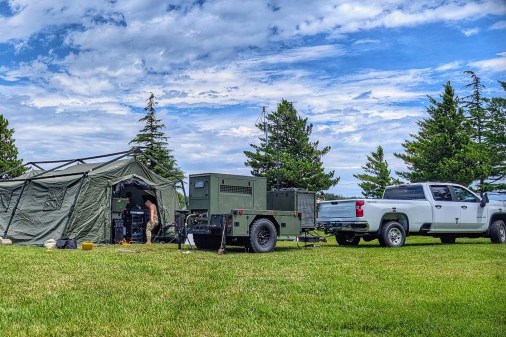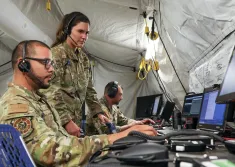Army planning 2025 prototyping activity for next-gen C2 effort

The Army is targeting a limited prototyping activity in fiscal 2025 and a minimum viable product for new command-and-control capabilities by early fiscal 2026.
The efforts surround what the Army calls “Next Gen C2,” a top priority of the service’s highest leadership to include the chief of staff and Futures Command.
Officials have stated that current capabilities are not adequate to dominate on the modern battlefield against a sophisticated adversary. Thus, the service is attempting to overhaul how its systems are architected to improve data sharing and communications.
The organization held an industry day for Next Gen C2 on Sept. 16 and released a request for information Sept. 30 for input on the acquisition approach, contracting strategy and possible scope for a minimum viable product. The feedback from the RFI is expected to shape a draft request for proposals that the Army hopes to have ready by mid-November.
Both officials and industry sources have indicated they want to have an open dialogue to inform what the future capability looks like.
To set the foundation of Next Gen C2, the Army is initially focusing on a data layer.
“We think that’s centered around a data architecture, a data layer. We think that the initial foray into that would be some applications around fires and collaboration and some common services across the data layer for chat, for PLI, for graphics,” Mark Kitz, the program executive officer for command, control, communications and networks, said in an interview. “These are really just some initial ideas that we’re exploring with industry, but we really want this to be informed by industry.”
One of the challenges that Futures Command and the acquisition teams are trying to solve is that currently, data and applications aren’t standardized. They’re also siloed and can’t necessarily share seamlessly.
“What we don’t want to have happen is every different specialty in the Army has their own box and they’re trying to make the boxes communicate,” Col. Matt Skaggs, director of tactical applications and architecture at Army Futures Command, said in an interview.
Capabilities such as the Advanced Field Artillery Tactical Data System and the Army Intelligence Data Platform, along with others, don’t necessarily talk seamlessly to one another, Skaggs said, adding: “What we want to build is with the integrated data layer, applications that have all those warfighting function workflows baked in, so we don’t have to have boxes talking to boxes, and all of those applications that I mentioned before are converged onto one user interface.”
In trying to do things differently this time around, the Army is taking lessons from its Command Post Computing Environment (CPCE), a program that began around seven years ago. It’s a web-enabled capability that sought to consolidate mission systems and programs into a single user interface at command posts to provide a common operational picture.
Officials and industry sources noted that with CPCE, the Army tried to do too much and the technology was not mature enough yet. While successful at delivering a C2 situational awareness tool, the infrastructure was not built in a way to share data across different functions such as intelligence, fires, electronic warfare and sustainment, among others.
“The technology of today will allow us to more robustly build a data layer that our applications then can sit on without us molding into one data model and molding into one application or one commercial infrastructure,” Kitz said. “One of the big lessons learned here is ensuring that these applications, these disparate capabilities, these warfighting functions can innovate within their domain area, but sharing data across a common layer, across a common data mesh … We’re doing this very differently by stimulating a dialogue with industry and using their input along with experimentation, along with the lessons learned of CPCE, and really more smartly looking at Next Gen C2 in terms of what is the art of today and the art of the possible.”
Officials noted that the CPCE architecture had to have a data translation device in the middle of all functions to make sure data models could talk to other data models — a cumbersome and unreliable process.
“That’s fundamentally what we’re trying to solve with our integrated base data layer,” Skaggs said. “There’s no more data translation. We have integrated data ingest point where all the data is coming to one place. It’s being curated, normalized, correlated and then pushed up to the applications equally. Then those applications equally feed that data layer, so everyone’s talking to one another.”
Also, as part of the effort, the Army is working on mitigating dependencies on the cloud.
“From the network perspective is edge compute, placing a lot of emphasis on how do we and the vendors that we’ve worked with there … best process data at the edge so we’re minimizing the amount of data that needs to reach back to the cloud,” Col. Mike Kaloostian, director of transportation and network security for Army Futures Command, said. “It’s like our transition from being completely dependent on the cloud to being too enabled by the cloud. Just once again, understanding if an adversary takes our connectivity or at least reduces our connectivity to the cloud at a certain phase of an operation, per se, and we’re still going to be able to process the data that we’re going to need, our commanders will still be able to see and visualize and collaborate with his or her teams and subordinate units, so we can still do that. That’s been really our focus is thinking about that a little bit differently than the Army has done in the past.”
The service wants the Next Gen C2 efforts to have open competition from the beginning and through the lifecycle of the program.
As part of that approach, there will be multiple contract efforts, vehicles and portfolios as opposed to a single, monolithic award.
“This is going to be a portfolio of contracts, SBIRs, whatever we determined for this limited prototyping. But we are going to absolutely look at all of the tools available to us in terms of contracting,” Kitz said. “We see this very much as a multiple award. At industry day, we made it very clear, even in the limited prototyping, we expect to award to two or three vendors so that all three of those vendors have opportunities with units to deliver capability and prove that they can get after this data layer with a diverse application set sitting on top of it. We anticipate, even in the very early stages, of carrying multiple vendors. And we hope that we get proposed very different approaches to how they would solve the problem, so that we can learn about it and as we go to minimum viable capabilities with units, we can learn and iterate over time.”
C2 Fix and the bridge
As it eyes next-generation command and control, the Army is also pursing an effort dubbed C2 Fix, which focuses on so-called “fight tonight” capabilities, essentially improving the current systems in preparation for a more permanent next-generation capability.
This initiative will serve as a solutions bridge until future capabilities are developed and fielded to soldiers.
A key aspect of both efforts relates to transport, according to officials. That includes things like proliferated low-Earth orbit transport for satellite communications, latency requirements and how to obfuscate in the spectrum.
“We need to understand, and our commanders need to understand, what his or her signature looks like. That’s a survivability thing, so it’s important … that they understand what they look like. We give them the capability to understand what they look like from a spectrum standpoint, the EMS. But how you obfuscate, how you use decoys to be able to fool an enemy [is important] as well,” Kaloostian said. “To me, it’s related to Next Gen C2. It’s not at the data layer and all the stuff that Matt’s working on to make this really a data-centric C2 capability, but it is helping us think through areas that we’re making gains as an Army right now, what needs to carry over in the future, just knowing what the future fights could potentially look like.”
C2 Fix is also providing critical lessons for disaggregating forces and command posts across the battlespace to make them more mobile, and thus harder for enemies to target.
Getting to the next generation
While the Army has begun the process of reaching out to industry to set up an acquisition approach, it has also done much experimentation and science-and-technology efforts.
These activities have sought to define what the art of the possible is while developing ideas for what an architecture could look like or is needed.
The service has contracted out to a few companies such as Anduril, Palantir and Google to test multiple different options for mission command applications and provide commanders options for different viewpoints of data.
The recent NetModX experiment at Fort Dix, New Jersey, in September allowed the Army to test tenets of the network in a contested environment.
“At NetModX, we took the real network and contested that environment, … put that architecture in a much more scaled version of it that put that architecture on the real networks, and then jammed and pushed off waveforms and learned a whole bunch about what was working and not working,” Maj. Gen Patrick Ellis, director of the network cross-functional team, said. “I think industry, our industry partners are learning a ton as well because they got to see that this is what happens on an unstable network and things that just is not part of the normal business development process.”
The next step will be putting these Next Gen C2 concepts to the test at the Army’s Project Convergence Capstone 5 experiment in March 2025.
“That’s the proof of principle event. This is our Super Bowl from an experimentation standpoint. This is where everything’s going to come together,” Kaloostian said. “We will push more data than we have to this point and we will go through a more realistic scenario than we have done to this point. We will be contested in the spectrum as well. It is going to be very complicated. But the intent or what [AFC commander] Gen. [James] Rainey and [Chief of Staff] Gen. [Randy] George — the intent here is, when we get done with this proof of principle, that it validates that we’re at that prototype level, that minimum viable product. That’s where … Mr. Kitz and the team takes over.”






